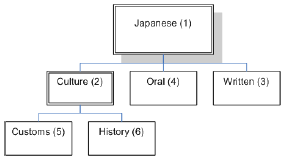Skill Hierarchies
When planning, it will sometimes be necessary to be very specific about a skill, whereas sometimes it will suffice to be somewhat more general.
For example, it will sometimes suffice to specify that an employee possesses the skill “Japanese,” whereas in other cases, it may be necessary to specify that an employee has the specific skill ”Japanese, written.” To be able to specify such differences in the necessary level of detail, it is possible to structure the skills into hierarchies.
The figure below illustrates an example of six skills grouped together in a hierarchy:

At the top level of the hierarchy, the skill “Japanese” (1) is found. This skill specifies that an employee has a general knowledge of Japanese. It is also possible to associate him with skill (3), “Japanese, Written,” which is a subskill of skill (1). This means that this employee has specific knowledge in written Japanese. Similarly, it is possible to specify whether an employee masters Japanese culture (2) or oral Japanese (4), which are also subskills of skill (1). Skills (5) and (6) make it possible to distinguish between employees having knowledge about Japanese culture within either customs or history. Since (5) and (6) are both subskills of (2), they are both also, indirectly, subskills of (1), as (2) is a subskill of (1).
It is possible to use different skill levels for two skills in a hierarchy. If an employee is, for example, assigned skills (3) and (6), he could, for instance, be assigned the level “Some” in “Japanese, Written” and “Novice” in “Japanese Culture, History.” The different skills in a hierarchy can also be assigned different level lists. This way it is, for example, possible to use one level list for specialized skills (typically at the bottom of the hierarchy) and another level list for the more general skills (typically at the top of the hierarchy).